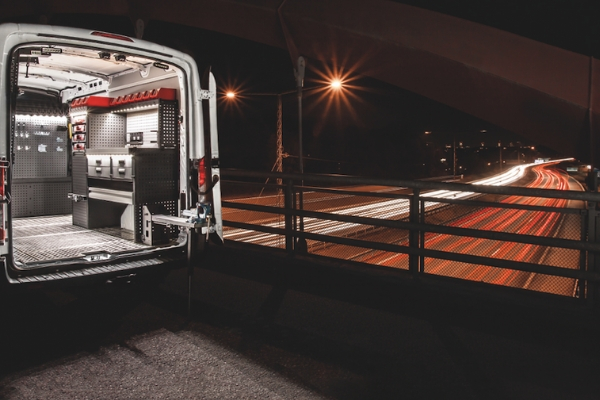The Benefits of DC-DC Battery Chargers

-
Many light commercial vehicles carry an increasing amount of electrical equipment. As such, more power is required to operate it. Auxiliary batteries are installed in vehicles to power this additional equipment.
Auxiliary batteries vary in size and specification and are used to operate equipment while away from mains power. A fully charged auxiliary battery is essential for many craftsmen who require a reliable power source to run their electrical equipment. Arriving at a job and being unable to carry out the work required could result in unsatisfied customers and lost income.
There are different types of auxiliary battery charging systems. The use of a Volt Sensitive Relay (VSR) is the more traditional choice. However, a DC-DC charger provides an innovative alternative. Both methods charge an auxiliary battery from the vehicle’s starter battery. Yet, they operate in different ways.
When using a relay to charge an auxiliary battery, the starter and auxiliary batteries are separated, allowing only the starter battery to be charged when the engine is started. When the charge voltage reaches a certain level, the relay engages, allowing both the starter and auxiliary batteries to be charged. When the engine is stopped and the battery voltage falls, the relay disengages; separating the starter and auxiliary batteries. The auxiliary battery is then able to power any equipment without draining the starter battery.
When using a relay, the auxiliary battery will always have a little less charge than the starter battery. In some cases, this may cause early failure of the battery due to sulfation. Furthermore, the charge current to the auxiliary battery will drop the more the starter battery is charged, thus taking longer to charge the auxiliary.
Today many commercial vehicle operators encounter problems with their batteries’ charging capacities. This is often due to the manufacturers designing their light vehicles with smart alternators in order to meet strict fuel consumption and emission targets. This makes it very difficult to charge an auxiliary battery by the traditional relay method. Although many vehicles are now fitted with smart alternators, they generally tend to still be fitted with a relay auxiliary charging system as standard.
Relays rely on voltage thresholds that trigger them to engage and disengage the starter and auxiliary batteries together, thus ensuring the auxiliary battery is charging whenever the engine is running. However, when a smart alternator has been installed, the output voltage can drop to a level that automatically disengages the relay. When the smart alternator output is below the charging voltage threshold, charging won’t happen. As such, the auxiliary battery will not receive as much charge as it would if connected to a system with a traditional alternator. As relays can engage and disengage frequently with the large and rapid voltage changes from a smart alternator, the high current contacts may also be prone to premature failure.
This is where DC-DC chargers come into their own. DC-DC chargers offer an effective alternative to relays. They work in a similar way to a battery charger that you’d use at home. Rather than plugging them into the mains however, they attach to the vehicle chassis battery. A DC-DC charger makes two completely separate electrical systems. When the engine’s not running, the starter and auxiliary batteries are electrically isolated. This ensures that neither battery can discharge the other and the auxiliary battery can always be fully charged. In light commercial vehicles with smart alternators, unlike a relay, a DC-DC charger takes the highly variable voltage output from the smart alternator and boosts or reduces it to an optimal charge voltage for the auxiliary battery at that specific time.
While vehicles with traditional alternators can use either a relay or DC-DC charger to charge the auxiliary battery, of the two options, a DC-DC charger will always provide a deeper state of charge.
Every battery has a maximum charge current and as such, it’s recommended to use a charger size that is suitable for that battery. Generally speaking, the smaller the battery, the lower the maximum charge current. If a battery can only absorb 25 amps, it will charge no quicker with a 40A charger than a 30A one. Therefore, a larger charger won’t necessarily charge the auxiliary battery any quicker than a smaller one.
Modul-System’s DC-DC 30A Charger incorporates specialist software that ensures it will charge the auxiliary battery quicker than other products on the market, without reducing battery life. With all the assembly material included, the Modul-System DC-DC Charger is easy to install and ensures the correct wiring parts and fusing are fitted. This simplifies the process and ensures swift installation. The Modul-Connect DC-DC Charger provides an effective charging solution for any auxiliary battery and ensures a reliable power source for craftsmen on the go.












 Subscribe to our newsletter
Subscribe to our newsletter